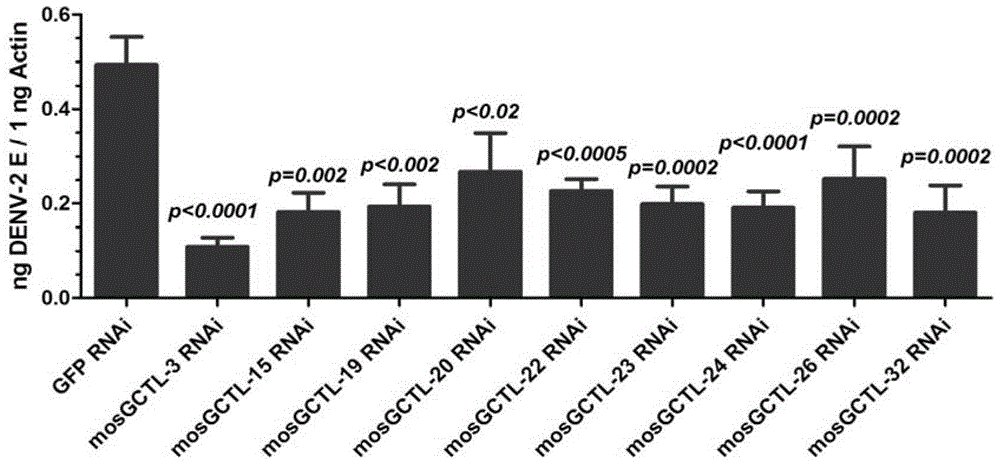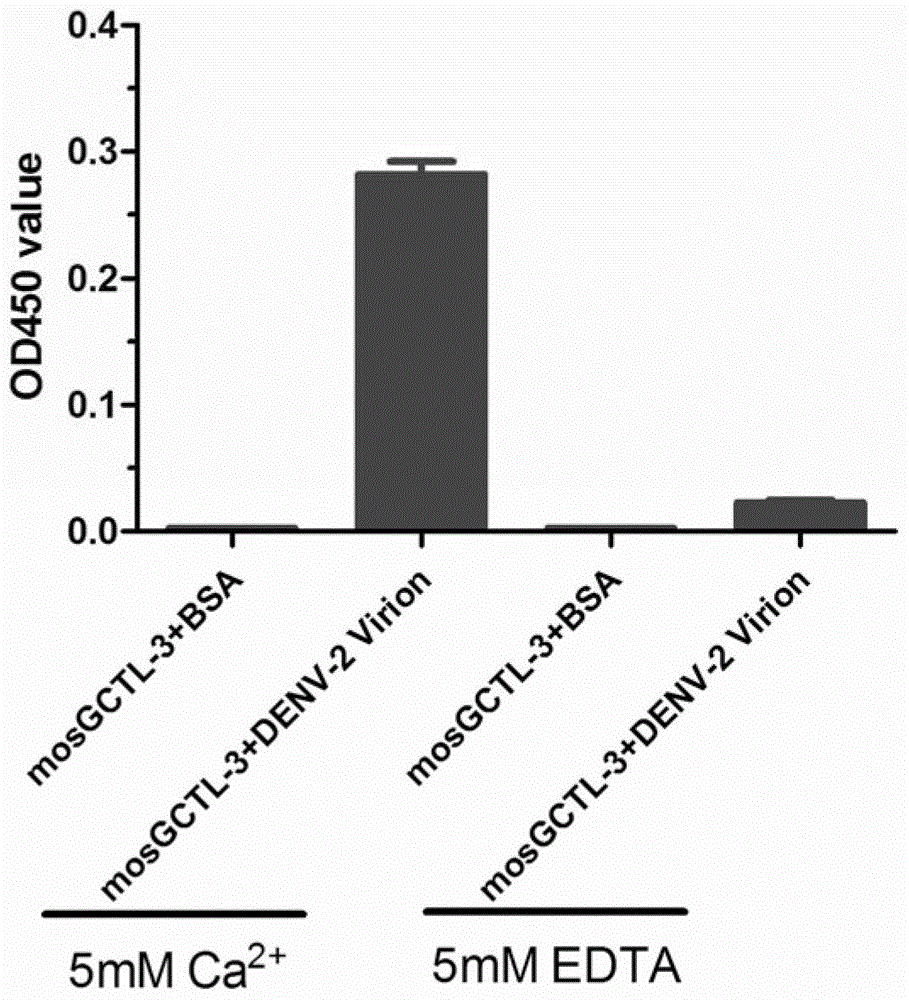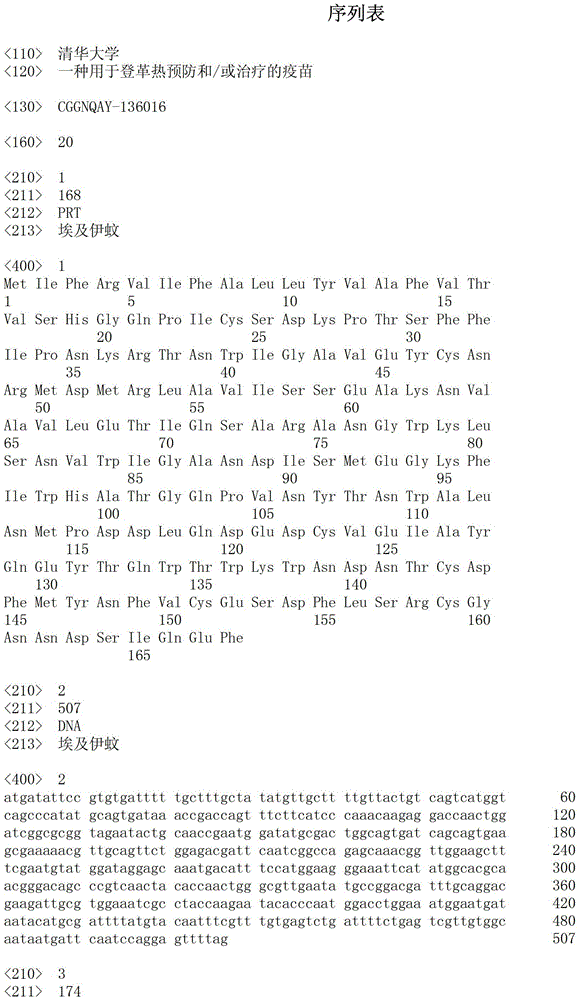A kind of vaccine for the prevention and/or treatment of dengue fever
A technology for dengue fever and dengue fever virus, applied in gene therapy, genetic material components, virus antigen components, etc., can solve the problems of reducing the safety of dengue fever vaccines, hindering the research and development of dengue fever vaccines, etc., and achieve the effect of reducing the virulence rate
- Summary
- Abstract
- Description
- Claims
- Application Information
AI Technical Summary
Problems solved by technology
Method used
Image
Examples
Embodiment 1
[0028] Embodiment 1, the application of the substance that inhibits mosGCTL-3 gene expression in inhibiting dengue fever virus replication
[0029] The C-type lectin subtype 3 of Aedes aegypti is also called mosGCTL-3 protein, as shown in sequence 1 of the sequence listing. The gene encoding mosGCTL-3 protein is also called mosGCTL-3 gene, and the coding region of its cDNA is shown in sequence 2 of the sequence listing.
[0030] 1. Design dsRNA
[0031] The dsRNA (dsRNA-1) designed to inhibit the expression of the mosGCTL-3 gene is the double-stranded RNA corresponding to the double-stranded DNA shown in the 1st to 333rd nucleotides from the 5' end of sequence 2 in the sequence listing.
[0032] The dsRNA (dsRNA-2) designed to inhibit the expression of the GFP gene is the double-stranded RNA shown in sequence 19 of the sequence listing.
[0033] 2. Application of substances that inhibit the expression of mosGCTL-3 gene in inhibiting the replication of dengue fever type 2 vir...
Embodiment 2
[0046] Embodiment 2, the application of the substance that inhibits mosGCTL-26 gene expression in inhibiting dengue fever virus replication
[0047] The C-type lectin subtype 26 of Aedes aegypti is also called mosGCTL-26 protein, as shown in sequence 3 of the sequence listing. The gene encoding mosGCTL-26 protein is also called mosGCTL-26 gene, and the coding region of its cDNA is shown in sequence 4 of the sequence listing.
[0048] 1. Design dsRNA
[0049] The dsRNA (dsRNA-3) designed to inhibit the expression of the mosGCTL-26 gene is the double-stranded RNA corresponding to the double-stranded DNA shown in the 31-381 nucleotides from the 5' end of sequence 4 in the sequence listing.
[0050] 2. Application of the substance inhibiting the expression of mosGCTL-26 gene in inhibiting the replication of dengue fever type 2 virus
[0051] 1. Divide Aedes aegypti into two groups, and carry out the following treatments respectively:
[0052] Experimental group: each Aedes aegy...
Embodiment 3
[0063] Embodiment 3, the application of the substance that inhibits mosGCTL-15 gene expression in inhibiting dengue fever virus replication
[0064] The C-type lectin subtype 15 of Aedes aegypti is also called mosGCTL-15 protein, as shown in sequence 5 of the sequence listing. The gene encoding mosGCTL-15 protein is also called mosGCTL-15 gene, and the coding region of its cDNA is shown in sequence 6 of the sequence listing.
[0065] 1. Design dsRNA
[0066] The dsRNA (dsRNA-4) designed to inhibit the expression of the mosGCTL-15 gene is the double-stranded RNA corresponding to the double-stranded DNA shown in the 79th to 407th nucleotides from the 5' end of sequence 6 in the sequence listing.
[0067] 2. Application of substances that inhibit the expression of mosGCTL-15 gene in inhibiting the replication of dengue fever type 2 virus
[0068] 1. Divide Aedes aegypti into two groups, and carry out the following treatments respectively:
[0069] Experimental group: each Aedes ...
PUM
 Login to View More
Login to View More Abstract
Description
Claims
Application Information
 Login to View More
Login to View More - R&D
- Intellectual Property
- Life Sciences
- Materials
- Tech Scout
- Unparalleled Data Quality
- Higher Quality Content
- 60% Fewer Hallucinations
Browse by: Latest US Patents, China's latest patents, Technical Efficacy Thesaurus, Application Domain, Technology Topic, Popular Technical Reports.
© 2025 PatSnap. All rights reserved.Legal|Privacy policy|Modern Slavery Act Transparency Statement|Sitemap|About US| Contact US: help@patsnap.com



